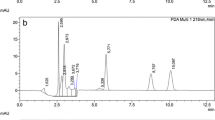Abstract
Cereal food products (n=333) were purchased in retail stores from Germany in 2001 and analysed for deoxynivalenol (DON), either by enzyme immunoassay or by HPLC after immunoaffinity chromatographic cleanup. Detection limits were dependent of the sample matrix and varied from 20–100 μg/kg. The overall DON incidence was 53%, with mean and median levels for positives of 251 μg/kg and 142 μg/kg, respectively. The contamination with DON (mean/median value, μg/kg) as found for bread (90/87), wheat flour (161/124), and noodles (472/297) indicate that the levels of DON in cereal foods were significant in view of the tolerable daily intake (1 μg/kg body weight) as established by the European Union scientific committee on food.
Similar content being viewed by others
Literatur
Bässen B, Thielert G (2000) Fusarientoxine (DON und ZEA) in Lebensmitteln. Mycotoxin Res. 16A: 75–78
Bockhorn I, Bockhorn A, Pohler S (2001) Deoxynivalenol (DON) in raw and cooked pasta. Mycotoxin Res. 17A: 67–70
Schmidt, S, Thielert G (2001) Fusarientoxine (DON und ZEA) in Mehl und Brot. Mycotoxin Res. 17A: 49–52
Taschan H, Puchtinger G, Waller U, Puchtinger T (2000) Deoxynivalenol in grain and grain products. Mycotoxin Res. 16A: 26–29
Usleber E, Märtlbauer E (1998) A limited survey of cereal foods from the German market for Fusarium toxins (deoxynivalenol, zearalenone, fumonisins). Arch. Lebensmittelhyg. 49: 42–45
Usleber E, Lepschy J, Märtlbauer E (2000) Deoxynivalenol in Mehlproben des Jahres 1999 aus dem Einzelhandel. Mycotoxin Res. 16A: 30–33
Woese K (2001) Monitoring of deoxynivalenol and zearalenone in cereals and cereal products from the state of Saxony-Anhalt, Germany. Mycotoxin Res. 17A: 45–48
Obst A, Lepschy J, Beck R, Bauer G, Bechtel A (2000) The risk of toxins by Fusarium graminearum in wheat - interactions between weather and agronomic factors. Mycotoxin Res. 16A: 16–20
Wissenschaftlicher Ausschuss für Lebensmittel der Europäischen Kommission, SCF (2002) Opinion of the Scientific Committee on Food on Fusarium toxins. Part 6: Group evaluation of T-2 toxin, HT-2 toxin, nivalenol and deoxynivalenol. SCF/CS/CNTM/MYC/27Final
Author information
Authors and Affiliations
Rights and permissions
About this article
Cite this article
Majerus, P., Curtui, V., Otteneder, H. et al. Deoxynivalenol in lebensmitteln: Ergebnisse einer Pilotstudie. Mycotox Res 18 (Suppl 1), 32–34 (2002). https://doi.org/10.1007/BF02946058
Issue Date:
DOI: https://doi.org/10.1007/BF02946058




